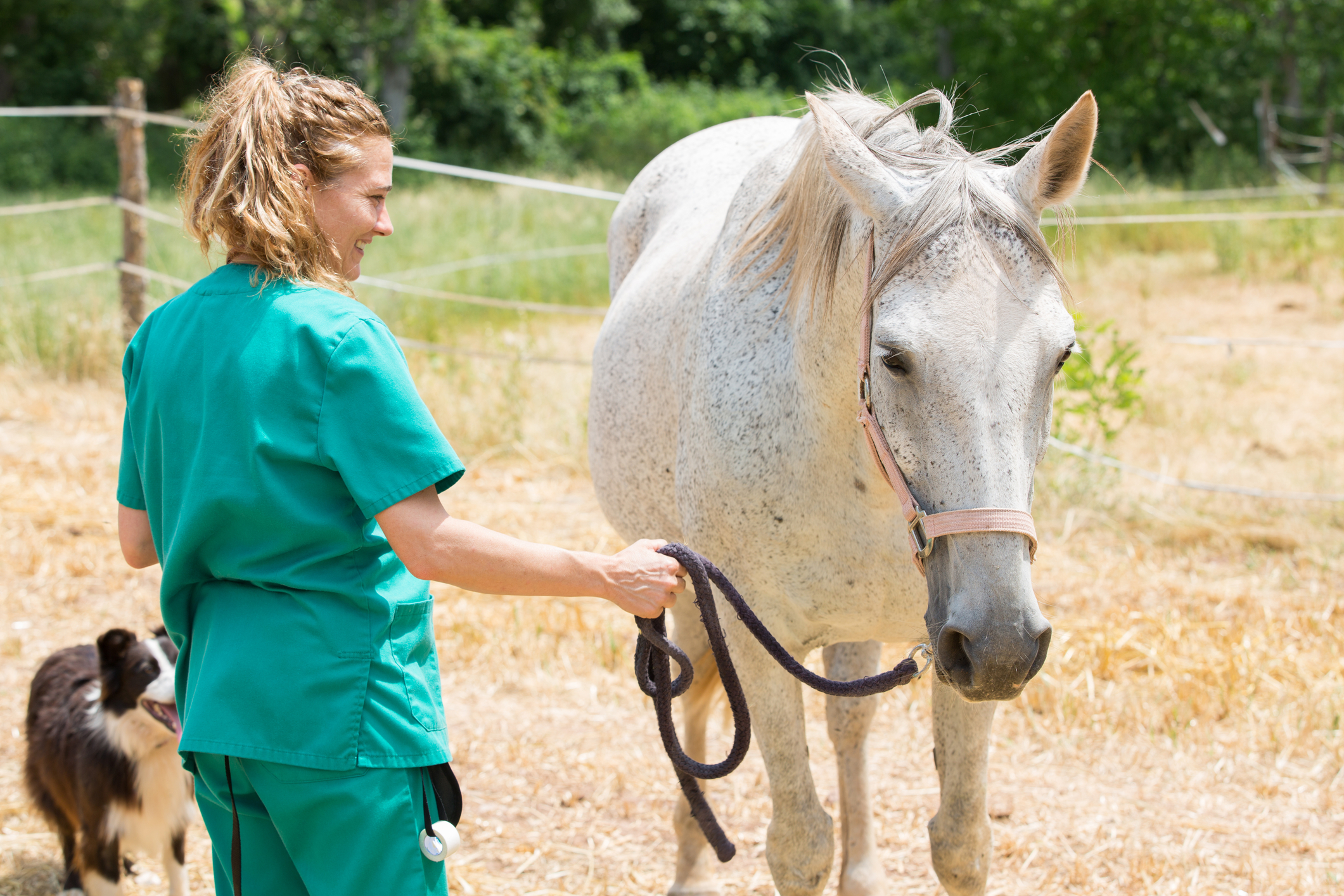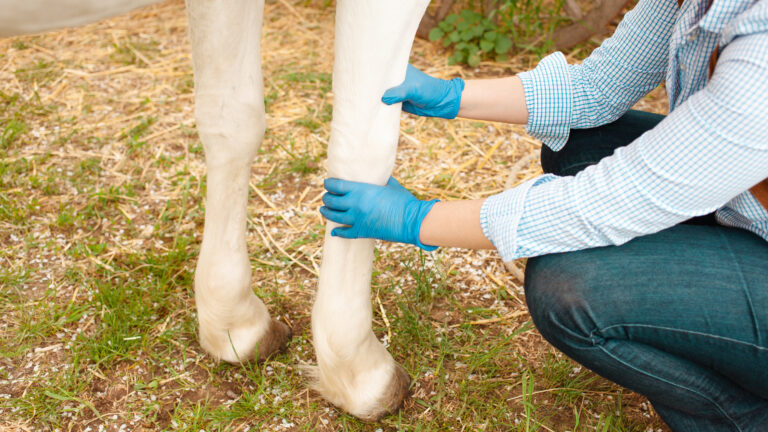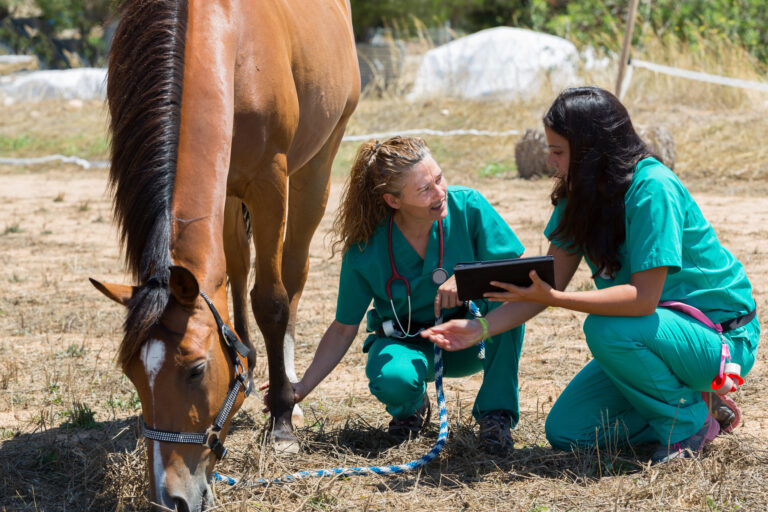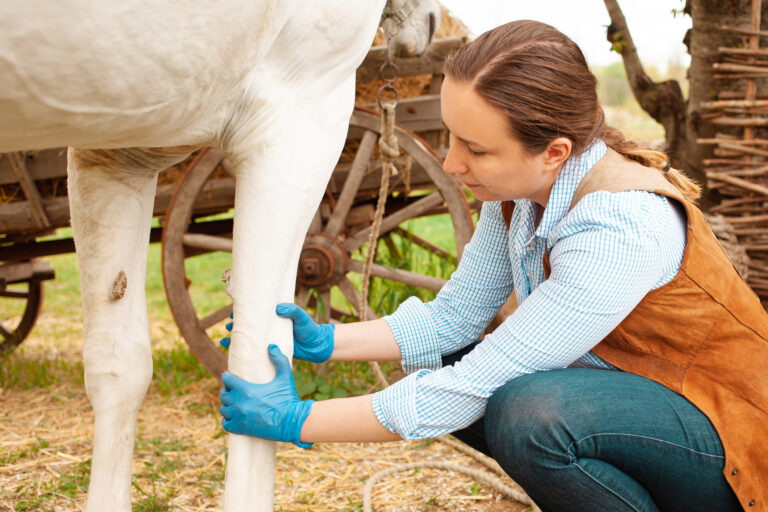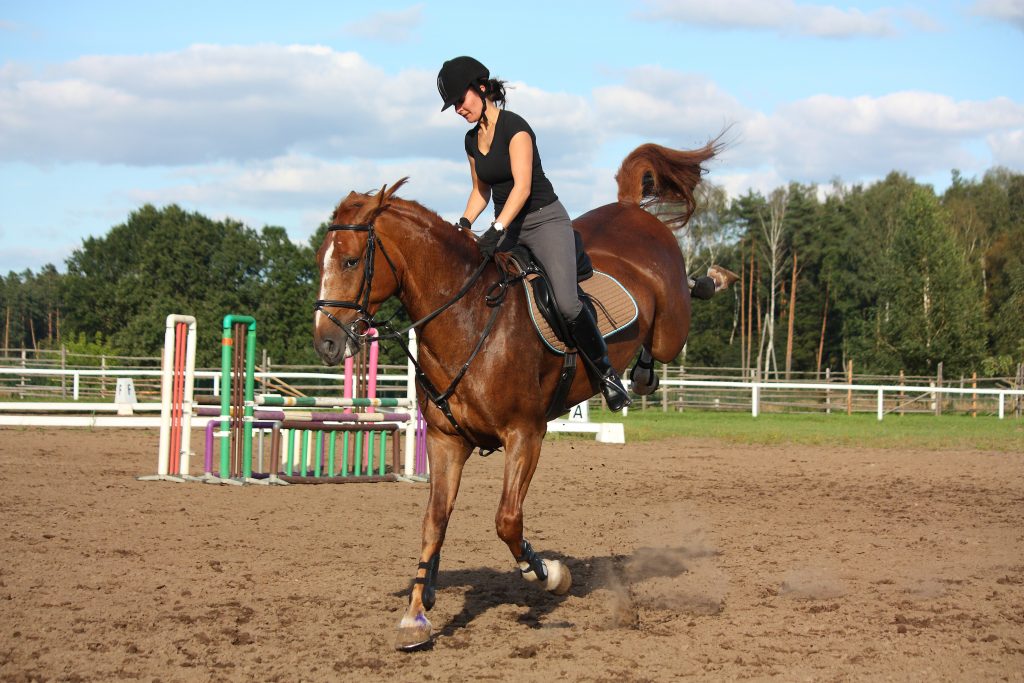Healing the Limp: Practical Advice on Equine Lameness Treatment and Prevention
When a horse comes up lame, it can feel overwhelming for both horse and owner. At Stride Vets, we understand that effective lameness management goes far beyond simply diagnosing the problem—it requires a comprehensive approach that encompasses immediate treatment, strategic rehabilitation, and proactive prevention. This guide provides practical, evidence-based advice to help you navigate the journey from injury to full recovery and beyond.
The Foundation of Successful Treatment: Early Intervention
“The best chance to correct a lameness is in the acute phase,” emphasizes Dr. Stephen Denton, a leading equine sports medicine veterinarian. When you notice something isn’t quite right with your horse’s movement, don’t wait. Early intervention can mean the difference between a minor setback and a career-ending injury.
Recognizing the Early Warning Signs
Before lameness becomes obvious, horses often show subtle changes that alert owners can spot:
- Slight reluctance to work
- Shortened stride length
- Resistance to lead changes
- Minor performance decline
- Heat or mild swelling in limbs
- Changes in attitude or behavior
Action point: Establish a baseline evaluation when your horse is sound. Use this as a comparison tool to detect early changes in movement patterns.
Modern Treatment Approaches: Beyond Rest and Time
Phase 1: Acute Management (0-3 Weeks)
During the initial inflammatory phase, the primary goals are controlling inflammation and preventing further damage.
Immediate interventions include:
- Controlled rest – Not complete stall confinement, but appropriate activity restriction
- Cryotherapy – 20-30 minutes of targeted icing (requires 10-15 minutes to reach therapeutic temperatures)
- Anti-inflammatory protocols – Both systemic and topical approaches
- Support bandaging – When appropriate for the condition
- Diagnostic imaging – To establish the exact nature and extent of injury
Critical insight: “If a horse is 4 out of 5 lame at the walk, even for just one day, there’s a good chance that injury is severe,” notes Dr. Carrie Schlachter, a leading rehabilitation specialist.
Phase 2: Active Treatment and Early Rehabilitation (3-8 Weeks)
Once inflammation subsides, this is the optimal window for targeted therapies and controlled movement.
Regenerative Medicine Options
Modern veterinary practice offers several regenerative therapies that help tissues self-heal rather than simply form weak scar tissue:
Platelet-Rich Plasma (PRP)
- Concentrates the horse’s own healing factors
- Ideal for early-phase tendon injuries
- Best applied in the 0-3 week window post-injury
Autologous Conditioned Serum (ACS/IRAP)
- Blocks inflammatory mediators
- Excellent for joint conditions
- Can be combined with other therapies
Stem Cell Therapy
- Shows promising results for severe soft tissue injuries
- Particularly effective for suspensory ligament injuries
- Requires specialized preparation and timing

Advanced Physical Therapies
Underwater Treadmill Therapy
- Reduces load while maintaining movement
- “Amazing for scar tissue in the lower legs” – Dr. Schlachter
- Increases range of motion effectively
- Particularly beneficial for horses needing controlled exercise
Extracorporeal Shock Wave Therapy
- Excellent for chronic conditions with scar tissue
- Stimulates healing in bone and soft tissue
- Often combined with other modalities
Therapeutic Ultrasound
- Promotes tissue healing through controlled heat
- Reduces inflammation and edema
- Useful for both acute and chronic conditions
Phase 3: Progressive Rehabilitation (8-16 Weeks)
This phase focuses on rebuilding strength, flexibility, and function while monitoring healing progress.
Condition-Specific Treatment Protocols
Soft Tissue Injuries (Tendons and Ligaments)
Tendon Injuries:
- Timeline: 6 months for mild injuries, longer for severe cases
- Deep digital flexor injuries: 1.5-2 years
- Early PRP followed by stem cell therapy often most effective
- Controlled exercise crucial – “some motion needs to start fairly early”
Ligament Injuries:
- Timeline: 8-9 months for moderate injuries, up to 2 years for severe
- “The vast majority respond really well to controlled exercise” – Dr. Schlachter
- Proximal suspensory injuries require 45-60 days before active rehabilitation
- Shock wave therapy particularly beneficial
Joint Conditions
Treatment approach typically includes:
- Intra-articular medications (steroids, hyaluronic acid, IRAP, PRP)
- Range of motion exercises
- Underwater treadmill therapy
- Anti-inflammatory protocols
- Possible arthroscopic intervention
Hoof Capsule Issues
Key considerations:
- 365-degree balance assessment (medial-lateral and dorsal-plantar)
- Consistent farriery schedule
- Evaluation of any recent shoeing changes
- 2-4 weeks underwater treadmill for “hoof capsule holidays”
The Progressive Return-to-Work Protocol
Standard 3-Month Rehabilitation Schedule
Weeks 1-4: Foundation Building
- Hand-walking: 10 minutes twice daily initially
- Progress based on soundness at walk with tight turns
- Veterinary re-evaluation at 6-8 weeks
Weeks 5-8: Introducing Tack Work
- Tack-walking under saddle
- Gradual increase in duration
- Introduction of ground poles for joint mobility
Weeks 9-12: Progressive Loading
- Addition of trot sets
- Gradual introduction of canter work
- Target: 15-30 minutes walking, 15 minutes trotting, 15 minutes cantering
Beyond 12 Weeks: Discipline-Specific Training
- Gradual return to sport-specific activities
- Continued monitoring and adjustment
- Full competition clearance only after complete protocols
Prevention: The Best Medicine
Building a Sound Foundation
Conditioning Principles:
- Progressive fitness development – “Just like human athletes, horses must be properly conditioned”
- Core strengthening exercises
- Cross-training on varied surfaces
- Cardiovascular base: Horses should manage 20 minutes continuous trotting (approximately 4 miles)
Early Life Preparation
“Prehabilitation” starts young:
- Moderate exercise from birth
- Adequate turnout for foals and young horses
- Proper nutrition for developing structures
- Avoiding prolonged stall confinement
Team-Based Management
Essential team members:
- Veterinarian – Regular health monitoring and lameness evaluations
- Farrier – Consistent 6-8 week shoeing cycles, proper balance
- Trainer/Rider – Daily observation and conditioning management
- Owner – Proactive monitoring and communication
Advanced Prevention Strategies
Hoof Care Excellence
Critical elements:
- Radiographic evaluation every 6-12 months for performance horses
- Consistent farriery schedule – never extend beyond 8 weeks
- Balance assessment including palmar/plantar angles and sole depth
- Early detection of laminitis, navicular changes, or imbalances
Environmental Management
Footing considerations:
- Consistent surface quality – avoid dramatic changes
- Proper arena maintenance – regular dragging and watering
- Surface matching – train on similar footing to competition surfaces
- Drainage and uniformity essential for safety
Lifestyle Factors
Weight management: “Being overweight puts a burden of stress on joints, ligaments, and tendons” – Dr. Hammer
Exercise variety:
- Maximum turnout when feasible
- Regular walking – “We don’t walk our horses enough”
- Long, low work to engage proper biomechanics
Thermal management:
- Judicious use of boots and wraps
- Proper cooling protocols post-exercise
- Cryotherapy when indicated
Monitoring and Technology
Objective Assessment Tools
Modern lameness detection:
- Motion sensor systems can detect lameness before visual observation
- Baseline measurements for comparison
- Objective data for treatment monitoring
Regular evaluation schedule:
- Pre-season soundness evaluations
- Bi-annual comprehensive examinations
- Post-competition assessments
Warning Signs Requiring Immediate Attention
Call your veterinarian immediately for:
- Sudden onset severe lameness
- Non-weight bearing lameness
- Heat and swelling in multiple limbs
- Signs of systemic illness with lameness
- Any lameness lasting more than 24 hours
The Role of Alternative Therapies
Evidence-Based Modalities
Proven beneficial:
- Pulsed electromagnetic field therapy (PEMF)
- Therapeutic massage
- Chiropractic care (by licensed professionals)
- Acupuncture and acupressure
Research recommendations:
- Try various therapies to find what works for your individual horse
- Combine with veterinary oversight
- Monitor cortisol levels and behavioral responses
- Investment should follow individual horse response
Nutritional Support for Recovery
Joint and Soft Tissue Health
Evidence-based supplements:
- Omega-3 fatty acids for anti-inflammatory effects
- Glucosamine and chondroitin for cartilage support
- MSM for connective tissue health
- Vitamin C and E for antioxidant support
Important note: Work with an equine nutritionist to develop appropriate supplementation protocols rather than relying on marketing claims.
Looking Forward: Emerging Treatments
Future Therapies on the Horizon
Secretome therapy: Cell-free products containing all beneficial factors from stem cells, offering consistent dosing and effects
Advanced imaging: More accessible MRI and CT for early problem detection
Genetic screening: Identifying horses predisposed to certain conditions
Biomechanical analysis: Sophisticated gait analysis for early intervention
Creating Your Lameness Prevention Plan
Monthly Assessment Checklist
Physical examination:
- Palpate all limbs for heat, swelling, or sensitivity
- Evaluate digital pulses
- Check hoof balance and shoe condition
- Assess overall body condition and weight
Movement evaluation:
- Watch horse move at walk and trot
- Note any irregularities or changes
- Evaluate willingness to work
- Monitor performance metrics
Environmental review:
- Assess footing conditions
- Review feeding program
- Evaluate turnout and exercise schedules
- Check equipment condition
Building Your Treatment Team
Questions to ask potential team members:
Veterinarian:
- Experience with your discipline
- Availability for emergencies
- Diagnostic capabilities on-site
- Rehabilitation philosophy and services
Farrier:
- Relationship with your veterinarian
- Experience with corrective shoeing
- Understanding of biomechanics
- Scheduling reliability
The Economics of Prevention vs. Treatment
Investment Perspective
Prevention costs:
- Regular veterinary examinations: £200-400 annually
- Consistent farriery: £600-1,000 annually
- Baseline diagnostics: £300-600 annually
- Total annual prevention: £1,100-2,000
Treatment costs:
- Acute lameness diagnosis: £500-1,500
- Advanced imaging: £800-2,000
- Regenerative therapies: £1,500-4,000
- Rehabilitation programs: £2,000-5,000
- Lost training/competition time: Variable but significant
The mathematics clearly favor prevention over treatment.
Conclusion: Partnering for Long-Term Soundness
Successful lameness treatment and prevention requires a proactive, team-based approach that begins before problems arise and continues throughout the horse’s career. At Stride Vets, we emphasize that every horse is an individual requiring customized care protocols.
The key principles for success include:
- Early recognition and intervention
- Evidence-based treatment protocols
- Progressive, monitored rehabilitation
- Comprehensive prevention strategies
- Strong veterinary-farrier-owner partnerships
Remember: “It’s always two steps forward and one step back” in rehabilitation, but with patience, proper protocols, and professional guidance, most horses can return to their previous level of performance.
Your Next Steps
If you notice any changes in your horse’s movement or performance, don’t wait. Contact Stride Vets for a comprehensive evaluation. Our experienced team provides cutting-edge diagnostic services, innovative treatment options, and customized rehabilitation programs designed to get your horse back to peak performance safely and efficiently.
Early intervention today prevents major problems tomorrow.
Sources:
- The Horse – 11 Equine Lameness Prevention Tips
- The Horse – Regenerative Therapies: Helping Horses Self-Heal
- The Horse – The Road to Recovery: Rehabilitating Horses With Lower-Limb Injuries
For professional consultation regarding lameness treatment and prevention, contact Stride Vets at stride-vets.co.uk. Our team provides comprehensive lameness services including advanced diagnostics, regenerative medicine, and rehabilitation programs.

